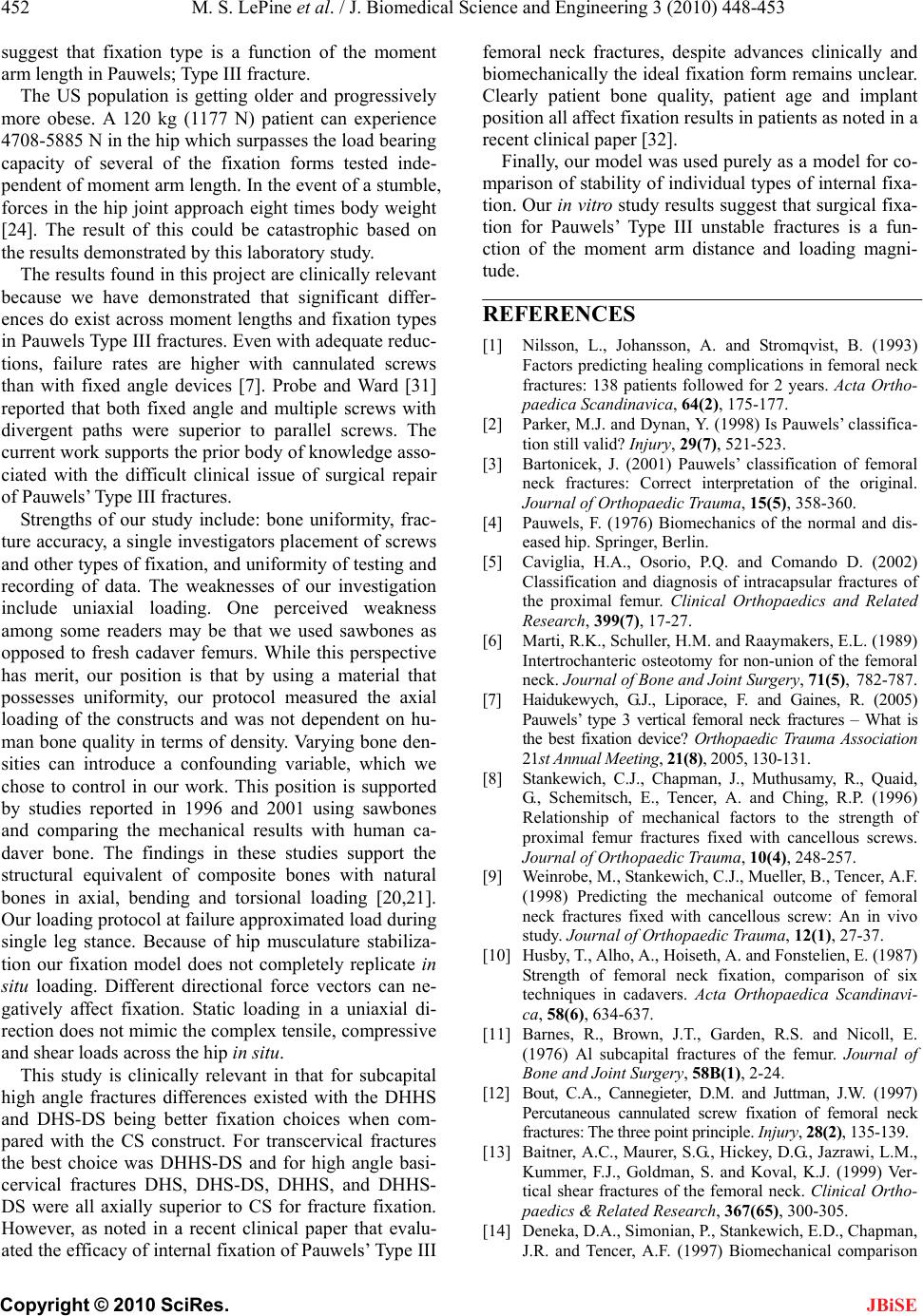
452 M. S. LePine et al. / J. Biomedical Science and Engineering 3 (2010) 448-453
Copyright © 2010 SciRes. JBiSE
suggest that fixation type is a function of the moment
arm length in Pauwels; Type III fracture.
The US population is getting older and progressively
more obese. A 120 kg (1177 N) patient can experience
4708-5885 N in the hip which surpasses the load bearing
capacity of several of the fixation forms tested inde-
pendent of moment arm length. In the event of a stumble,
forces in the hip joint approach eight times body weight
[24]. The result of this could be catastrophic based on
the results demonstrated by this laboratory study.
The results found in this project are clinically relevant
because we have demonstrated that significant differ-
ences do exist across moment lengths and fixation types
in Pauwels Type III fractures. Even with adequate reduc-
tions, failure rates are higher with cannulated screws
than with fixed angle devices [7]. Probe and Ward [31]
reported that both fixed angle and multiple screws with
divergent paths were superior to parallel screws. The
current work supports the prior body of knowledge asso-
ciated with the difficult clinical issue of surgical repair
of Pauwels’ Type III fractures.
Strengths of our study include: bone uniformity, frac-
ture accuracy, a single investigators placement of screws
and other types of fixation, and uniformity of testing and
recording of data. The weaknesses of our investigation
include uniaxial loading. One perceived weakness
among some readers may be that we used sawbones as
opposed to fresh cadaver femurs. While this perspective
has merit, our position is that by using a material that
possesses uniformity, our protocol measured the axial
loading of the constructs and was not dependent on hu-
man bone quality in terms of density. Varying bone den-
sities can introduce a confounding variable, which we
chose to control in our work. This position is supported
by studies reported in 1996 and 2001 using sawbones
and comparing the mechanical results with human ca-
daver bone. The findings in these studies support the
structural equivalent of composite bones with natural
bones in axial, bending and torsional loading [20,21].
Our loading protocol at failure approximated load during
single leg stance. Because of hip musculature stabiliza-
tion our fixation model does not completely replicate in
situ loading. Different directional force vectors can ne-
gatively affect fixation. Static loading in a uniaxial di-
rection does not mimic the complex tensile, compressive
and shear loads across the hip in situ.
This study is clinically relevant in that for subcapital
high angle fractures differences existed with the DHHS
and DHS-DS being better fixation choices when com-
pared with the CS construct. For transcervical fractures
the best choice was DHHS-DS and for high angle basi-
cervical fractures DHS, DHS-DS, DHHS, and DHHS-
DS were all axially superior to CS for fracture fixation.
However, as noted in a recent clinical paper that evalu-
ated the efficacy of internal fixation of Pauwels’ Type III
femoral neck fractures, despite advances clinically and
biomechanically the ideal fixation form remains unclear.
Clearly patient bone quality, patient age and implant
position all affect fixation results in patients as noted in a
recent clinical paper [32].
Finally, our model was used purely as a model for co-
mparison of stability of individual types of internal fixa-
tion. Our in vitro study results suggest that surgical fixa-
tion for Pauwels’ Type III unstable fractures is a fun-
ction of the moment arm distance and loading magni-
tude.
REFERENCES
[1] Nilsson, L., Johansson, A. and Stromqvist, B. (1993)
Factors predicting healing complications in femoral neck
fractures: 138 patients followed for 2 years. Acta Ortho-
paedica Scandinavica, 64(2), 175-177.
[2] Parker, M.J. and Dynan, Y. (1998) Is Pauwels’ classifica-
tion still valid? Injury, 29(7), 521-523.
[3] Bartonicek, J. (2001) Pauwels’ classification of femoral
neck fractures: Correct interpretation of the original.
Journal of Orthopaedic Trauma, 15(5), 358-360.
[4] Pauwels, F. (1976) Biomechanics of the normal and dis-
eased hip. Springer, Berlin.
[5] Caviglia, H.A., Osorio, P.Q. and Comando D. (2002)
Classification and diagnosis of intracapsular fractures of
the proximal femur. Clinical Orthopaedics and Related
Research, 399(7), 17-27.
[6] Marti, R.K., Schuller, H.M. and Raaymakers, E.L. (1989)
Intertrochanteric osteotomy for non-union of the femoral
neck. Journal of Bone and Joint Surgery, 71(5), 782-787.
[7] Haidukewych, G.J., Liporace, F. and Gaines, R. (2005)
Pauwels’ type 3 vertical femoral neck fractures – What is
the best fixation device? Orthopaedic Trauma Association
21st Annual Meeting, 21(8), 2005, 130-131.
[8] Stankewich, C.J., Chapman, J., Muthusamy, R., Quaid,
G., Schemitsch, E., Tencer, A. and Ching, R.P. (1996)
Relationship of mechanical factors to the strength of
proximal femur fractures fixed with cancellous screws.
Journal of Orthopaedic Trauma, 10(4), 248-257.
[9] Weinrobe, M., Stankewich, C.J., Mueller, B., Tencer, A.F.
(1998) Predicting the mechanical outcome of femoral
neck fractures fixed with cancellous screw: An in vivo
study. Journal of Orthopaedic Trauma, 12(1), 27-37.
[10] Husby, T., Alho, A., Hoiseth, A. and Fonstelien, E. (1987)
Strength of femoral neck fixation, comparison of six
techniques in cadavers. Acta Orthopaedica Scandinavi-
ca, 58(6), 634-637.
[11] Barnes, R., Brown, J.T., Garden, R.S. and Nicoll, E.
(1976) Al subcapital fractures of the femur. Journal of
Bone and Joint Surgery, 58B(1), 2-24.
[12] Bout, C.A., Cannegieter, D.M. and Juttman, J.W. (1997)
Percutaneous cannulated screw fixation of femoral neck
fractures: The three point principle. Injury, 28(2), 135-139.
[13] Baitner, A.C., Maurer, S.G., Hickey, D.G., Jazrawi, L.M.,
Kummer, F.J., Goldman, S. and Koval, K.J. (1999) Ver-
tical shear fractures of the femoral neck. Clinical Ortho-
paedics & Related Research, 367(65), 300-305.
[14] Deneka, D.A., Simonian, P., Stankewich, E.D., Chapman,
J.R. and Tencer, A.F. (1997) Biomechanical comparison